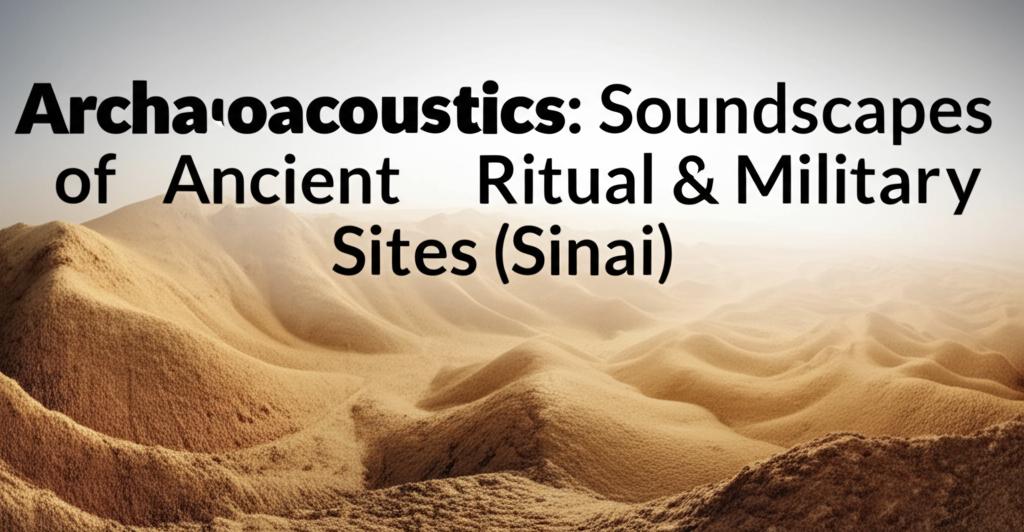Archaeoacoustics offers a unique window into the sensory experiences of past civilizations, exploring how sound shaped their rituals, social practices, and even warfare. By examining the acoustic properties of ancient sites, researchers can uncover intentional design in how sound was utilized and perceived. This field combines archaeology, acoustics, anthropology, and other scientific disciplines to reconstruct the soundscapes of places like temples, tombs, caves, and military installations.
A key aspect of archaeoacoustics is the analysis of how sound traveled within these spaces and its potential role in ceremonies, communication, or cultural events. Researchers investigate phenomena like echoes, resonance, and reverberation, which could have held symbolic, religious, or practical importance. For instance, the strategic placement of rock art in areas with specific acoustic properties suggests a deliberate choice to enhance ritualistic experiences, where sounds might appear to emanate directly from the painted figures.
In the context of ritual sites, archaeoacoustics reveals how ancient peoples may have engineered sound for emotional and cognitive manipulation. The selection of specific locations for sacred structures often correlated with unique natural acoustic characteristics, such as the presence of ultrasound or infrasound. These non-audible frequencies can subtly influence psychological states, potentially inducing feelings of awe, fear, or other sensations that could amplify mystical or religious experiences. Ancient civilizations may have possessed an intuitive understanding of these phenomena, choosing sites where natural vibrations could enhance rituals and create a deeper connection to the spiritual realm. The design of sacred spaces, including elements like domes, arches, and specific materials, further manipulated sound to create spiritually evocative environments.
Regarding military sites, archaeoacoustics can shed light on how sound was employed in battle strategies and communication. While specific research on Sinai military sites in this context is not extensively detailed in the provided search results, the general principles of archaeoacoustics suggest that the acoustic properties of landscapes and fortifications could have been factors in ancient warfare. The study of infrasound, for example, notes its potential use in warfare for its disorienting effects. High-frequency sounds, due to their directionality, also have applications in acoustic weaponry. Understanding the natural soundscape and how it could be manipulated would have been a valuable asset in military contexts for signaling, intimidation, or gaining a tactical advantage.
The Sinai Peninsula itself is a region rich in historical and religious significance, with sites like St. Catherine's Monastery, Mount Sinai, and Serabit el-Khadim. While specific archaeoacoustic studies focused on the military and ritual soundscapes of Sinai are not widely represented in current literature, the existing research in archaeoacoustics globally provides a strong framework for how such investigations could proceed. The ancient Egyptians, known to have mined turquoise in Sinai at sites like Serabit el-Khadim, also had a sophisticated understanding of sound in their religious practices, utilizing instruments like the sistrum in temple rituals. The call to prayer (Athan) from mosques is a significant element of the soundscape in many Arab cities, including those in Egypt, highlighting the ongoing cultural importance of sound in the region.
Modern archaeoacoustic research employs advanced techniques such as:
- Acoustic Measurement: Using microphones and sound level meters to capture the current acoustics of a site.
- Computer Modeling and Simulation: Creating digital 3D models of sites to simulate how sound would have behaved in the past, even if the site is now in ruins. Software like CATT-Acoustic, Odeon, and EASE are commonly used.
- Auralization: Recreating the sound of ancient spaces so they can be experienced aurally.
- Experimental Archaeology: Using replicas of ancient instruments or vocalizations to test the acoustics of sites.
- Analysis of Artifacts: Studying ancient musical instruments to understand their contribution to the soundscape.
Despite the growing interest and advancements in archaeoacoustics, there remains a significant gap in research across many regions, including much of the Arab world and potentially specific applications within the Sinai Peninsula. Future research in this area could yield fascinating insights into how ancient inhabitants of Sinai experienced and utilized sound in their most sacred rituals and critical military endeavors.

